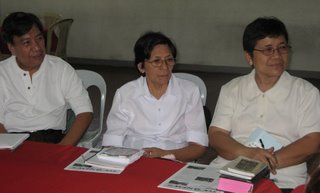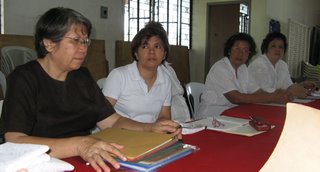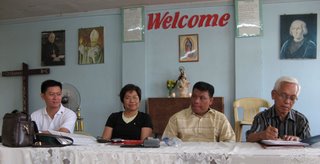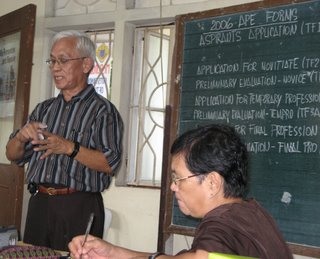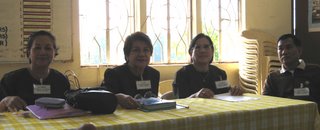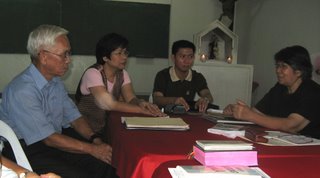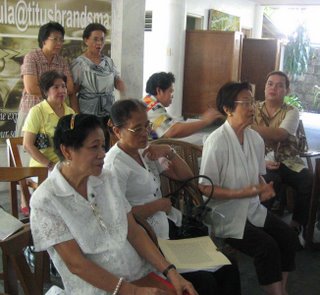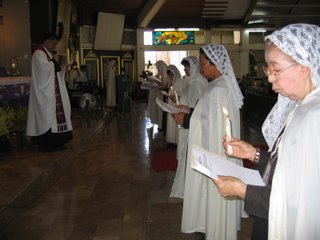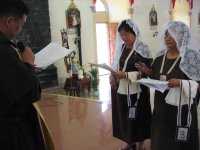I left the country last November to fulfill my role as a doting lola to my one and only two year old grandson and to keep house for the young family of my eldest son who recently migrated to Australia.
Half-heartedly, I left behind my two families, my daughter and my other son at home as well as my TOC family in Pilar, Las Piñas City. I’ve grown so accustomed to my daily house routines and to the regular weekly and monthly activities with my Carmelite brothers and sisters that it was difficult for me to leave without any qualm or misgiving.
Sometimes however God disturbs the life you have been used to in order to rock the boat of your comfortable habitual existence. Just like verbal prayers, God does not want us to fall into a ‘rote exercise’ where the heart is no longer engaged because the words just automatically flow from the lips without feelings anymore. In short, in Australia, I did not have the usually comfortable "do whatever you please" life. Of course, my ‘apo’ is a delight to be with and will always be. However, it was not my house and I didn’t have ‘the call’ for anything. For the first time, I experienced being totally dependent on others, on my food, on my activities (I can’t go places except when I’m with them). Their activities were also my activities and I felt I did not exist as an individual who can independently plan to do what I wish.
It was by God’s grace that our Natl. Prioress, Sis. Nimfa suggested that I contact Pamela Dewhurst, an OCarm TOC who was living in Canberra where I also stayed. First, being blessedly single, she made time to accommodate me despite her busy schedule. Second, being an active Carmelite (her apostolate was caring for the sick and the elderly which also included traveling to distant parts of Australia to care for her older relatives), I witnessed how, through listening, God provides each ‘willing hand’ a beautiful ministry.
Pam is 73 years old and has been an Isolate Carmelite all her life (that is more than 50 years). She is an Isolate because she has no community in Canberra. Furthermore, although there are four (4) of them in the same area, they are actually far from one another because of the vastness of Australia. At least 3 times a year, they do try to meet over lunch or when somebody is around, they contact each other. Other than that, on their own, they have to take care of their spiritual growth. Pam said she gets her regular ongoing formation from their TOC newsletter, "The Vine", because (like our own TOC News), it contains articles rich in Carmelite teachings. For any important matter, she receives communications direct from the National Office situated in distant Victoria. Otherwise, she pursues her journey to Carmel all alone.
We met thrice during my stay there. And every meeting was always an edifying experience for me, for here was a 73-year-old woman who was very active in her Carmelite ministry of spreading the faith through her care for the sick and the elderly. Today, she has now centered her life on this. She has a deep Carmelite spirituality and she speaks about it with fervor. She talks animatedly about God and exudes God’s love in the way she treats people (the first time we met, she treated me like a long lost friend).
I was truly humbled by this woman who single-handedly, without the support of any community, was able to transform herself into a deeply committed Carmelite through her fastidious effort to learn more about Carmel (she has subscription to a lot of Catholic publications and reads a lot of spiritual books – yes, she truly sounds well rooted in God). I felt inadequate with my ministry as I saw her untiring service to the sick and lonely aged people. Being a stranger in Australia, she provided for me a sterling inspiration to hold on to Carmel’s treasures.
In Australia, I felt like I was also an Isolate Carmelite. I did not have any community to meet with. It was all up to me to keep the flame of my love for Carmel burning in the midst of loneliness, boredom and isolation. ‘Loneliness’ for those I left behind; ‘boredom’ for the life of being in the house day in and day out with very little respite from the humdrum of exactly doing the same thing everyday in the four corners of our home; and then ‘isolation’ for not being able to socialize with anyone else except with my ‘housemates’. I had no other friends, and although I found a very dear friend in Pam, I did not want to disturb her unnecessarily because she was always up and about with her apostolate. She was seldom at home.
What kept me going were the emails from a friend who is a ‘soul-companion’ in my spiritual journey as well as the very inspirational, informative, and thought-provoking writings from our fellow Carmelites in the blogspot which our very own National Prioress has so brilliantly made available for everyone to read anywhere in the world.
Without a community, I still felt in touch with our Philippine Carmel family through the emails/websites. It was with great gusto that I relish every article and I was often amazed with the depth of the writer’s grasp of the topic. It certainly showed that those who wrote the articles spent long hours of silent love before God. Articles were written with much reflection, with much personal first-hand experiences and with a generous amount of love and interconnectedness with the readers. These were my ‘spiritual oases’ far away from home.
Now that I’m back, I realized that it was not really that difficult to be an Isolate. But then, maybe it was not hard for me because I started my formation with a very loving and supportive TOC community where we were committed to grow and struggle with our difficulties together as a family of God. Maybe, it was also because I resolved to be always in touch with my Carmelite family through emails. It may also be because I kept Carmel in my heart through my readings. Maybe, because my thirst to know and to live the spirituality never ebbed but continually grew stronger in the midst of a spiritual drought of Carmel’s well in Australia.
And so to be an Isolate Carmelite, I believe we must first of all have the great desire to embrace the spirituality. To this desire, we must add the commitment to pursue the quest for Carmel relentlessly. How? We must exert effort to be in regular contact with the National Office here in Manila, wherever we may be. We must undergo academic formation not only from those that will come from the National Office, but from our own personal labor to grow in the knowledge of God. We should not put to waste the benefits, which are available from the lives and teachings of our Carmelite saints and from the ‘written sharings’ that we get from our brothers and sisters in Carmel.
It will also be a great aid to have a ‘soul-companion’ in this journey, for we need the support and guidance of somebody who has genuine concern for our spiritual welfare. Lastly, it is much better and often highly recommended, that we get a good spiritual director who could ably chart our journey amidst the tempestuous sea of our trials and temptations to the sure road of Carmel’s peak.
Now, if you ask me, "Which one would you prefer, to be in a community or to be an isolate?" I would certainly want to belong to a community. The physical, social, emotional and spiritual support that a community can give me is something I wouldn’t want to miss. Of course, there are squabbles, misunderstandings, competitions and all kinds of pettiness that can go with it. But hey! Even at home, we don’t have a perfect family. All those things are parts of our rough edges that God is so kindly honing ever so slowly, so carefully and so patiently to prepare us for an entrance to the next mansion. And even if we don’t have the community, God can always provide other people to serve the same purpose. I’d much prefer my TOC family to do this than to have others who are not of ‘like mind’ to fulfill the role.

